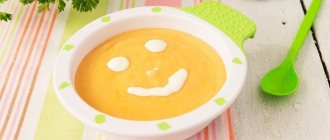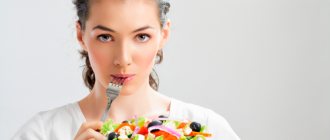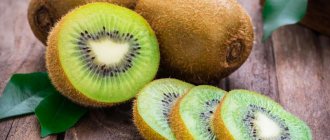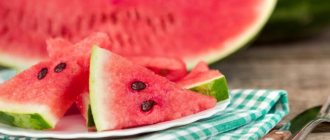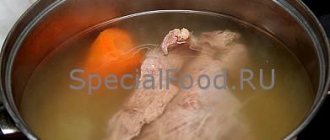Crab sticks are a product that has become quite popular in Russia in recent decades. Imitation crab meat, raw or fried, is often used to prepare salads and other dishes, replacing expensive seafood.
Can a mother who is breastfeeding her baby eat crab sticks? Let's figure out what this product is made of.
Manufacturing technology
Imitation crab meat is an artificially created product that has an affordable price and acts as a substitute for expensive natural seafood.
The raw material for making crab sticks is finely ground meat of inexpensive white fish, or specially processed fish protein - surimi.
To obtain surimi, chopped pollock, blue whiting or hake fillets are repeatedly washed with clean, chilled fresh water, as a result of which the soluble components are washed out from the resulting mass, leaving pure insoluble protein.
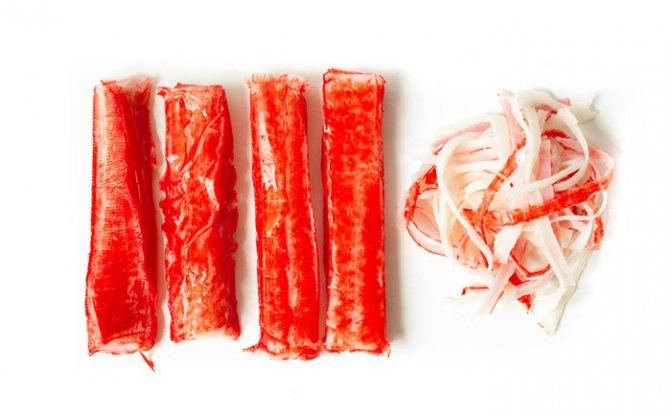
Excess moisture from the washed mass is removed using a centrifuge, then surimi is formed into large blocks and sent to blast freezing chambers. From the processing site, surimi is transported to factories for the production of imitation seafood. There, crab sticks are formed and given their characteristic appearance using dyes, salt and artificial flavors.
Is there any benefit?
Surimi crab sticks usually have a layered structure - they can be carefully “unwound”. The nutritional value of imitation crab meat is minimal - apart from protein, the sticks contain practically nothing useful, since the technology for making surimi and repeated freezing of the finished product leads to the loss of vitamins and microelements originally contained in white fish.
The highest quality crab sticks, made from surimi or minced white fish fillets, contain:
- protein;
- a meager set of amino acids, trace elements and vitamins;
- preservatives;
- artificial colors and flavors;
- flavor enhancer.
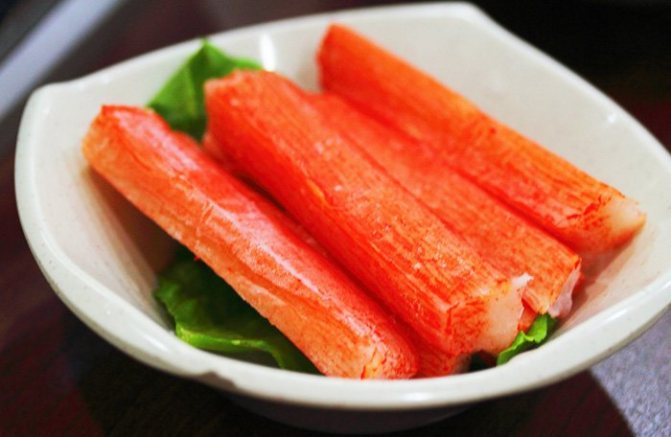
It can hardly be recommended to include this product in the menu of a nursing mother, since all the “chemicals” will inevitably end up in breast milk and the baby’s body. It should also be taken into account that Chinese products that arrive en masse on Russian shelves are often not made from surimi.
They include:
- soy protein;
- starch;
- egg white;
- artificial colors and flavors;
- preservatives and flavor enhancers.
Even healthy adults, not only women during lactation, should not consume such products. In an infant, this combination of ingredients can cause a severe allergic reaction, serious disruption of the digestive system, and damage to internal organs.
Salad for a nursing mother in the first month
After childbirth, dishes are prepared from vegetables that have undergone good heat treatment. Preference should be given to baked, boiled, stewed vegetables. Eating fried foods during the first month of motherhood is prohibited.
If a month-old baby suffers from colic, then you should not lean on salads. The fiber they contain will further strain the newborn’s stomach, leading to cramps. It is necessary to limit salt intake. It causes swelling, retaining water in the body, and worsens the taste of milk. You can replace it with dried seaweed. It is healthy and contains a lot of iodine. If you have problems with the thyroid gland, you should consult a specialist. To normalize lactation, preference is given to salads with cottage cheese, carrots, cheese and nuts.
Don't be afraid to experiment with snacks and salads as long as your baby doesn't have a negative reaction. They will bring you a boost of vivacity, energy and good mood.
Salads with corn
Crab sticks taste well with canned corn, which is why salads with these products are among the most popular today. Is it possible for a nursing mother to eat some of this salad on a holiday?
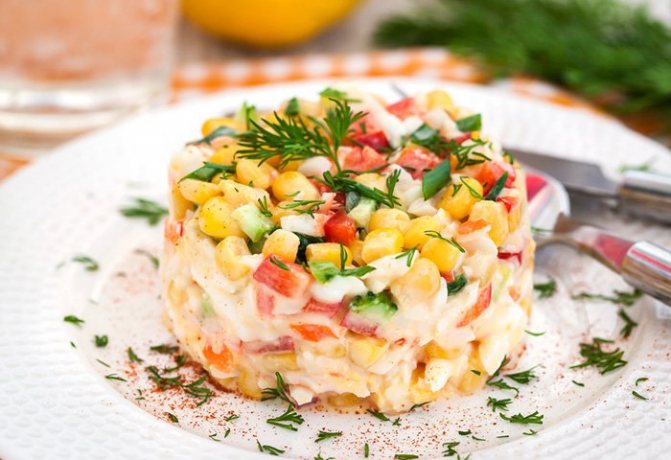
If mom is not allergic to fish and seafood, a small amount of salad with high-quality imitation crab meat will not cause much harm. But it is necessary to monitor the child’s reaction to each of the potentially dangerous ingredients in the salad in advance. Crab sticks and corn should be introduced into the diet little by little and alternately, at intervals of a week.
If the baby exhibits an allergic reaction, increased excitability, or indigestion, experiments must be postponed for a long time or stopped completely, depending on the degree of reaction of the child’s body.
You can try adding corn and crab sticks to the menu of a nursing mother if her baby is at least six months old - until this age, the baby’s digestive system is not sufficiently adapted to new complex foods.
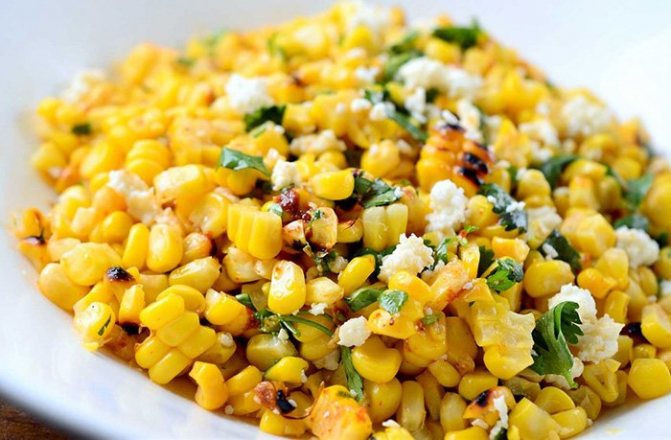
How can corn be harmful? The cereal itself is hypoallergenic - it does not contain gluten, a vegetable protein to which children often exhibit a pronounced reaction. At the same time, corn contributes to increased gas formation. If a child does not experience bloating or colic when a nursing mother eats corn, the product is safe for him.
You should pay attention to the potential danger of canned corn for a breastfed baby: preservatives, flavor enhancers, and dyes negatively affect the baby’s fragile body.
When assessing whether certain foods can be consumed without harm to the baby, a nursing mother must take into account all the risks to the child’s health.
On the eve of the holidays, many nursing mothers are salivating from the abundance of prepared dishes, and there is nothing surprising here.
A strict diet can lead to nervous tension for the mother, so occasionally it’s worth pampering yourself with salads, but is it possible to have crab salad while breastfeeding? After all, many people love it so much that it is difficult to find a person indifferent to it, but first mothers should figure out whether it will cause harm during lactation.
What salads can a nursing mother eat?
Many women feel that their food choices are very limited when breastfeeding. However, if you use your imagination and choose the right ingredients, you will be able to prepare many healthy and balanced dishes. When choosing products you need to remember certain rules:
- Buy dietary meat (turkey, rabbit, beef). You need to cook it yourself, and not buy ready-made smoked and dried sausages, sausages, etc.
- Fish is an allergen, so you should be careful with fish dishes. Is it possible for a nursing mother to have crab salad? The answer is obvious, no, crab sticks contain dyes. If you use natural crab when preparing a dish, you should make sure that your child does not have allergies.
- When breastfeeding, it is good to eat a lot of different greens, lettuce, and fresh vegetables. These foods are rich in fiber, will help cope with intestinal problems and replenish vitamin deficiencies. A nursing mother should not eat this salad in the first month of motherhood.
- We treat brightly colored fruits and vegetables (red apples, beets, tomatoes) with caution. These products are allergens. It is better to choose green vegetables (cucumbers, green beans). Iceberg lettuce is also allowed during breastfeeding.
- Variety is one of the principles of maternal nutrition. In the first weeks of a baby’s life, we establish which foods the baby does not have a negative reaction to. We boldly introduce them into the diet. Nutrition should be balanced.
- There are no restrictions on the menu. There should be no diets. Salads will help you eat healthy and balanced. They are rich in fiber, which will help relieve constipation.
- Include simple and delicious recipes in your diet. Dishes should be prepared from familiar products, eaten fresh, immediately after preparation. Salad left in the refrigerator can harm your baby's digestion.
- It is good to eat multi-component dishes that are rich in proteins, carbohydrates, fats and vitamins. Be sure to include potatoes, green vegetables, eggs, lean meat, sour cream, and cottage cheese in your diet.
- Don't skip fruit salads. It is good to use bananas, pears, peaches, and apples for them. Don’t forget to check your child’s reaction to each fruit separately.
Mom can eat fruit, fish, vegetable, and meat salads. They need to be prepared in such a way that they bring maximum benefits to the body.
Is it possible to have crab salad during lactation?
A product that imitates crab meat - crab sticks - has recently become quite popular. It has proven itself excellent both in various salads in its natural form and in heat treatments, for example in baked hot appetizers.
It is also impossible not to note its acceptable price category, in contrast to expensive seafood.
The classic recipe for crab salad consists of: crab sticks, canned corn, eggs and mayonnaise. Many people add other ingredients if desired, but we will evaluate the benefits or harm during breastfeeding in this combination. Before drawing conclusions, you need to know what the main components of the salad consist of.
The production process of crab sticks and their benefits
Crab sticks that imitate expensive seafood are created artificially. For their production, inexpensive crushed white fish or surimi is used - fish protein, which is processed in a special way.
- To obtain it, fillets of hake, pollock or blue whiting are ground.
- Next, the fish puree is washed many times with cold water, after which the soluble components are expelled from the mass, resulting in pure protein.
- With certain functions of production equipment, excess moisture is extracted from the contents, large blocks are formed, which are subjected to shock freezing.
- After making surimi, it is sent to the next production cycle - factories for imitation seafood.
- Due to salt, dyes and synthetic flavors, crab sticks are formed according to a characteristic pattern.
What salad should a nursing mother prepare for breastfeeding?
On the eve of the holidays, many nursing mothers are salivating from the abundance of prepared dishes, and there is nothing surprising here. A strict diet can lead to nervous tension for the mother, so occasionally it’s worth pampering yourself with salads, but is it possible to have crab salad while breastfeeding?
After all, many people love it so much that it is difficult to find a person indifferent to it, but first mothers should figure out whether it will cause harm during lactation. A product that imitates crab meat - crab sticks - has recently become quite popular. It has proven itself excellent both in various salads in its natural form and in heat treatments, for example in baked hot appetizers.
The classic recipe for crab salad consists of: crab sticks, canned corn, eggs and mayonnaise. Many people add other ingredients if desired, but we will evaluate the benefits or harm during breastfeeding in this combination.
Before drawing conclusions, you need to know what the main components of the salad consist of. Crab sticks that imitate expensive seafood are created artificially. For their production, inexpensive crushed white fish or surimi is used - fish protein, which is processed in a special way. Sticks made from surimi have a multi-layer structure, and can be unrolled if desired. The nutritional value of this product leaves much to be desired, since besides protein there is no other benefit.
This is due to the fact that double freezing contributes to the loss of all vitamins and microelements found in white fish. From this we can conclude that this product is not one of the useful ones, and therefore the use of all of the above chemicals is highly undesirable, because it will undoubtedly pass into breast milk, and then into the baby’s body.
The reaction of the baby’s body can be the most unpredictable. It is very sad, but in general it is very difficult to find even such crab sticks among the assortment of store shelves. Most manufacturers further reduce the cost of the product manufacturing process by only using a combination of soy and egg whites, starch, synthetic dyes, flavors, preservatives and flavor enhancers.
What can you say about nursing mothers, because even an ordinary person should refuse to use them. Many people know that the combination of crab sticks and canned corn is successful.
It is one of the most popular and delicious. In the absence of allergic reactions to seafood in the mother, high-quality crab sticks will not cause too much harm, which cannot be said about canned corn, which is too allergenic and instantly causes increased flatulence in the baby.
You can try corn at the initial stage, one teaspoon at a time, and only if the child has no allergic reactions, digestive disorders or colic. Otherwise, it is necessary to completely abandon or at least delay its use.
Many experts advise nursing mothers to consume boiled chicken eggs. In general, infants respond well to egg whites, provided, of course, that the product is fresh and properly prepared. Therefore, the risk of an allergic reaction to it will be minimal.
Crab salad when breastfeeding with eggs, of course, will seem very tasty and harmless, but in practice this is not the case. It can cause many problems for both mother and child. Everyone knows what a large amount of chemicals industrial mayonnaise contains.
And what do you think, if it is dangerous for an ordinary healthy person to eat, then what can we say about a nursing mother?! One has only to look at the composition indicated on the label to appreciate the complexity of the situation. A big misconception is the fact that homemade mayonnaise is absolutely harmless during lactation, because this is far from the case.
The presence of raw eggs alone can provoke allergic reactions, and in the worst case, salmonellosis. This is not just harmful, but also life-threatening for an adult, and even more so for a child. After reading this article, many should have answered the question themselves: is it possible to have crab salad while breastfeeding? According to experts, all components of this dish are complex and unsafe, as they are stuffed with various synthetic additives.
If a nursing mother really wants it, then each ingredient must be introduced into the diet separately, since the salad in its entirety can immediately provoke digestive disorders and serious liver problems in the child. To avoid an irreversible process, be patient and give up crab salad for the lactation period! Take care of your baby and you will be happy and healthy!
Add a comment Cancel reply. Your email address will not be published. This site uses Akismet to reduce spam. Find out how your comment data is processed. Information and services for parents.
Mom's news Family lawyer Family holidays Home cooking. Crab salad for a nursing mother. Nutrition for a nursing mother Updated February 11 0 Rating: Please rate the article.
Add a comment Cancel reply Your email address will not be published.
Register Login.
Features of salads for nursing mothers
What salads can nursing mothers eat? At this time, you are allowed to eat light salads: boiled beets with prunes, grated carrots with green apple, pickled cucumbers and tomatoes, salad with beef, herbs and vegetable oil. As a dressing, you can use vegetable oil, low-fat yogurt or a couple of spoons of sour cream. If a feast is planned, then a nursing mother can try harmful, “Crab” or “Olivier”, but no more than two tablespoons.
After the child is 3 months old, you can expand the diet. A new dish is introduced once every 3-4 days to monitor the reaction. Eggs, chicken meat, tomatoes, fruits and other products that mother had previously denied herself are gradually being added to the menu. Thus, if the child does not have allergies, all food restrictions on the mother’s menu can be lifted by the baby’s six months.
During this period, it is allowed to diversify the diet of a nursing mother with salads containing poultry, chicken and quail eggs, tomatoes, peppers, olives and other products. In the spring, you can try to supplement the menu with vegetable salads: radishes with sour cream and herbs, boiled eggs with young green onions and sour cream.
In autumn, vinaigrette and fried eggplants are added to the diet. Mayonnaise salads should still be consumed with caution and in small portions, as they can provoke allergic reactions.
Crab salad for a nursing mother
When breastfeeding, young mothers exclude a whole range of dishes from their diet. In the first weeks of a child’s life, a nursing mother should pay special attention to a variety of salads and steamed dishes. Contents 1. What should a nursing mother eat? Features of salads for nursing mothers 3. Salad recipes 3. Meat salads 3. Chicken salad with walnuts 3.
Olivier 3. Caesar 3. Royal Night 3. Vegetable salads 3. Greek 3. Cauliflower with nuts 3. Kohlrabi with carrots 3. Crab salad 3. Herring under a fur coat 4. Homemade mayonnaise for salads 5. Video on the topic of the article 6. Questions readers and expert answers What should a nursing mother eat? After childbirth, to establish successful lactation, you need to avoid foods that can cause allergies in the baby. Honey, seafood, eggs, nuts, sauces, vegetables and fruits of red, yellow and orange should be completely excluded from the diet.
At this time, most mothers experience infant colic. Doctors have not found a direct relationship between the diet of nursing mothers and abdominal problems in the baby, while some foods can cause increased and painful gas formation in the child, which means they should be excluded from the diet. It is impossible to predict in advance what foods the baby’s intestines will react to with colic; the mother must focus on her body and sensations. In most cases, it is necessary to determine the culprits of gas leaks empirically.
For three months you should not overuse cabbage, potatoes, dairy products and legumes (peas, beans, lentils). What salads can nursing mothers eat?
At this time, you are allowed to eat light salads: boiled beets with prunes, grated carrots with green apple, pickled cucumbers and tomatoes, salad with beef, herbs and vegetable oil. As a dressing, you can use vegetable oil, low-fat yogurt or a couple of spoons of sour cream. After the child is 3 months old, you can expand the diet. A new dish is introduced once a day to monitor the reaction.
Eggs, chicken meat, tomatoes, fruits and other products that mother had previously denied herself are gradually being added to the menu. Thus, if the child does not have allergies, all food restrictions on the mother’s menu can be lifted by the baby’s six months. During this period, it is allowed to diversify the diet of a nursing mother with salads containing poultry, chicken and quail eggs, tomatoes, peppers, olives and other products.
In the spring, you can try to supplement the menu with vegetable salads: radishes with sour cream and herbs, boiled eggs with young green onions and sour cream. In autumn, vinaigrette and fried eggplants are added to the diet. Mayonnaise salads should still be consumed with caution and in small portions, as they can provoke allergic reactions.
Boiled meat is used in the menu of nursing mothers both as an independent dish and as a component for salad. There are a great variety of meat salads. When choosing a recipe, you can rely on your preferences. You can take the basic ingredients as a basis:. Cooking process: prepare the ingredients - wash and boil the vegetables, boil the beef in salted water. Cool all components. Peel potatoes, eggs, carrots. Cut all ingredients into small equal cubes.
Beef can be cut into slightly larger pieces. Add green peas to the bowl. Prepare the filling: add spices and salt to taste to the yogurt. Pour the sauce into the salad and mix gently. Decorate with greens. To add a variety of taste to Olivier, add pieces of avocado, peeled apple or cottage cheese. A light salad that has become popular lately. Its ingredients are suitable for a harmonious exit from the diet menu of a nursing mother. For preparation you will need the following products:.
A delicious salad that looks good both on a holiday table and on an ordinary day. For the salad you will need the following ingredients:. Vegetable salads are an important part of a nursing mother's diet; they contain important vitamins and microelements, so they must be eaten daily. One of the most popular vegetable salads lately is Greek salad. Young nursing mothers may benefit from an equally tasty alternative.
For the salad you will need the following ingredients:. Chop the washed and dried vegetables into large pieces 1x1 cm. Cut the curd cheese into medium cubes and lightly salt it. Place the salad in a bowl in the following order: layer of vegetables, layer of cottage cheese, garnish the mixture with basil leaves. We will need:. All greens must be washed, dried and chopped. Then you need to boil the eggs hard and cut them into halves or quarters. Mix the ingredients, seasoning the salad with oil and salt. The cabbage needs to be washed, divided into inflorescences, pour boiling water and cook until tender in salted water.
At this time, make the sauce: combine sour cream, salt, half a bunch of dill and finely chopped nuts. Place the finished cabbage in a dish, pour over the sauce and garnish with the remaining herbs. Wash the kohlrabi and carrots, dry them and grate the vegetables.
Boil the eggs hard and finely chop the whites; we will need the yolks for the sauce and green onions. Garnish the finished dish with finely chopped parsley and dill. A delicious salad for seafood lovers, it will appeal to mothers in their third or more months of breastfeeding. Early introduction into the diet may cause an allergic reaction. In the process of preparing the ingredients, it is necessary to defrost the sticks and clean them from the packaging.
Boil the eggs and peel them. Wash and dry the greens, boil the rice. Cut the crab sticks into cubes, chop the onion, herbs, and eggs. Add boiled rice to the bowl. Season the salad with homemade mayonnaise. It is easy to replace chicken eggs with quail eggs, doubling their quantity. Mayonnaise is the most popular dressing for meat and vegetable salads. Unfortunately, store-bought sauces cannot be called healthy in any way - a whole range of preservatives, additives and flavor enhancers can adversely affect the health of the baby and mother.
An alternative to store-bought sauce can be homemade mayonnaise. The recipe impresses with its simplicity and speed of preparation. For homemade mayonnaise you will need:. Cooking process. Beat milk with vegetable oil in a blender until thick. It will take seconds. Add mustard, salt and lemon juice, beat the mixture with a blender for another 10 seconds. The output is ml. In the maternity hospital I left the bottom line - 17 extra kilos.
For the first three months, I ate boiled beet salads with a spoonful of sour cream for dinner. Both tasty and healthy, and no problems with the baby’s tummy. Author of this article, are you sure that this article is for nursing mothers? You could simply write: eat everything!
The diet of a nursing mother involves giving up a number of foods.
Salad Recipes
Meat salads
Boiled meat is used in the menu of nursing mothers both as an independent dish and as a component for salad. There are a great variety of meat salads. When choosing a recipe, you can rely on your preferences.
Chicken salad with walnuts
Since some foods may not be “liked” by your baby’s tummy, it is better not to include this salad in your diet before 3 months from the start of feeding. You can take the basic ingredients as a basis:
- chicken fillet – 200 g;
- eggs – 4 pcs.;
- walnuts – 50 gr.;
- green apples – 1 pc.;
- cheese – 50 gr.;
- yogurt – 100 ml;
- garlic – 1 clove;
- salt to taste.
The cooking process takes no more than 20 minutes. Let's look at it step by step:
- cut the fillet into small cubes, chop the eggs, grate the apples and cheese on a medium grater;
- fry the nuts in a frying pan, grind in a blender;
- prepare the filling: mix yogurt, salt and garlic;
- lay out the salad in layers, soak each layer with the filling;
- the sequence of laying out the layers is eggs + meat + nuts + apples + cheese.
It is better to season the salad with homemade mayonnaise or yogurt-based sauce
Olivie
Delicious and everyone's favorite salad. Sausage in Olivier can be easily replaced with boiled meat. Ingredients:
- boiled potatoes - 3 medium tubers;
- boiled carrots – 1 medium;
- boiled beef – 50 grams;
- fresh or salted cucumbers – 50 g;
- eggs – 2 chicken, or 4 quail;
- homemade mayonnaise or low-fat yogurt;
- green peas – 50 grams;
- salt, spices to taste;
- greenery.
Cooking process: prepare the ingredients - wash and boil the vegetables, boil the beef in salted water. Cool all components. Peel potatoes, eggs, carrots. Cut all ingredients into small equal cubes. Beef can be cut into slightly larger pieces. Add green peas to the bowl. Prepare the filling: add spices and salt to taste to the yogurt. Pour the sauce into the salad and mix gently. Decorate with greens. To add a variety of taste to Olivier, add pieces of avocado, peeled apple or cottage cheese.
Caesar
A light salad that has become popular lately. Its ingredients are suitable for a harmonious exit from the diet menu of a nursing mother. For preparation you will need the following products:
- chicken breast – 300 grams;
- white or wheat loaf - 2 small pieces;
- hard cheese – 50 grams;
- sesame seeds – 30 grams;
- lettuce leaves - 1 bunch;
- odorless olive or sunflower oil - for dressing.
Cooking time 15-20 minutes. Let's look at the process step by step:
- Boil the chicken breast until done. Cool the breast, use chicken broth for diet soup.
- Cut the bread slices into pieces measuring 1*1 centimeter. The pieces must be dried in a frying pan without oil until medium brown.
- Wash the lettuce leaves and dry with paper towels. Cut off the roots.
- Fry the sesame seeds a little in a dry frying pan. The seeds become golden brown in literally 2-3 minutes.
- Tear the lettuce leaves into small pieces with your hands. Place the leaves in a deep plate and sprinkle sesame seeds on top.
- Cut the breast into small pieces and place in a bowl. If desired, do not cut the chicken, but divide it into fibers.
- Place toasted bread in a salad bowl. Sprinkle grated cheese on top and season with vegetable oil.
Royal night
A delicious salad that looks good both on a holiday table and on an ordinary day. For the salad you will need the following ingredients:
- chicken or turkey fillet – 200 gr.;
- yesterday's loaf - 2 pieces;
- chicken eggs – 2 pcs.;
- cheese – 80 gr.;
- tomato – 3 pcs.;
- sour cream or yogurt – 100 gr.
Homemade mayonnaise for salads
Mayonnaise is the most popular dressing for meat and vegetable salads. Unfortunately, store-bought sauces cannot be called healthy in any way - a whole range of preservatives, additives and flavor enhancers can adversely affect the health of the baby and mother. An alternative to store-bought sauce can be homemade mayonnaise. The recipe impresses with its simplicity and speed of preparation. For homemade mayonnaise you will need:
- milk (any fat content) - 100 ml;
- vegetable oil of flavor - 250 ml;
- mustard - 1 tsp;
- lemon juice - 1–2 tbsp;
- salt (to taste) - 0.5 tsp.
Cooking process. Beat milk with vegetable oil in a blender until thick. This will take 10-15 seconds. Add mustard, salt and lemon juice, beat the mixture with a blender for another 10 seconds. The output is 400-450 ml. mayonnaise.
